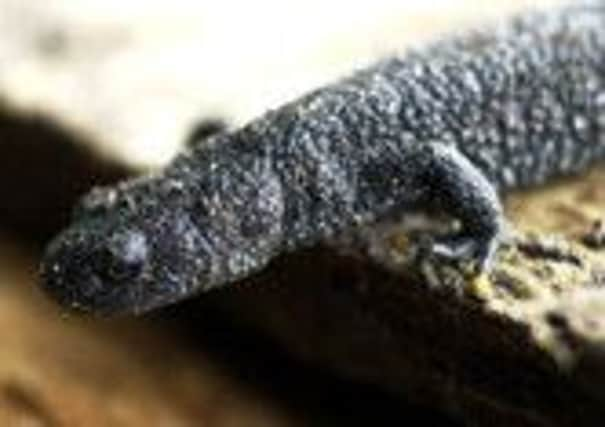No expense spared in relocation of protected newts


But these newts have been machine cut from stainless steel and incorporated in a so-called ‘Newt Route’ as an artistic reminder to shoppers that the plush new £90 million Vangarde retail park at Monks Cross - the new Yorkshire home for stores like John Lewis, M&S and Next - is shared with a real live colony of endangered great crested newts.
Paving stones pun on the name, with vignettes of information such as “Newty sleep: Great crested newts hibernate between October and March”. It is made light of now but it produced a headache for the site’s developers, Wetherby-based Oakgate Group. Work was delayed from October 2012 until April 2013 while the newts hibernated.
Advertisement
Hide AdAdvertisement
Hide AdWhen they awoke ecologists had to catch each one and transfer them in buckets to new ponds on the edge of the development. The entire operation cost over £500,000.
The great crested is the largest of the UK’s three native newts, growing to over six inches long. In spring the male develops a jagged crest along its back and a flash of white down its tail. Their breeding season is March-June, when the females lay around 250 eggs.
The species is in decline, say Natural England. A 2006 survey found it to be widespread across the Midlands and South-east but less common in Yorkshire. Its breeding sites - usually small to medium-sized ponds which hold water through the summer - are threatened by pollution, new farming methods, development and drying out.
It is protected by European legislation and by UK laws. The penalty for killing a single newt or disturbing its habitat is a £5,000 fine or six months imprisonment.
Advertisement
Hide AdAdvertisement
Hide AdOakgate’s managing director Richard France, applied for a license to move the newts. “The penalties are pretty draconian if you do things that Natural England consider to be deliberate. The fine or prison sentence is actually for each newt, and we eventually found over 300 of them. People got a lot of amusement by asking me how long I was going to be in jail for.”
The 30-acre site used to consist of fields bounded by drainage ditches and was originally earmarked for an HSBC data centre. A survey revealed the presence of smooth newts, which are not protected by law, but the discovery of a small colony of great crested newts proved to be the show-stopper.
When the bank scheme was dropped, Oakgate put in ponds for the newts before work on the proposed shopping development could begin. But higher than average summer rainfall which meant the colony of newts expanded from nine to a total of 320.
Ecologist Dr Mark Hampton, who oversaw the newts’ relocation, said they bred in trenches from an archaeological dig in 2005 which usually dried up in May. But the wettest summer in 100 years in 2012 meant the newts had an exceptional breeding season.
Advertisement
Hide AdAdvertisement
Hide AdWhen the population boon was discovered the newts were about to hibernate and no work could be done until daytime temperatures topped 5C.
Mr France said: “As things turned out, the spring of 2013 was the coldest and latest for many years. When the newts finally emerged we had about a two-week window, and I thought if we don’t get them all out now it’s going to really start costing us. But fortunately we got them all. It was a very frustrating time.”
When the site was free of the newts, work began on the retail park. Meanwhile, the new ponds were surrounded by walls which the newts couldn’t climb. To allow them to reach other protected ponds on the site, newt tunnels costing £100,000 were installed under the retail park’s internal roads.
Mr France helped to relocate the newts, but did he develop a soft spot for them? He says, possibly through gritted teeth: “Nice little creatures. I certainly respect them. They’re a species that have had problems in life.”